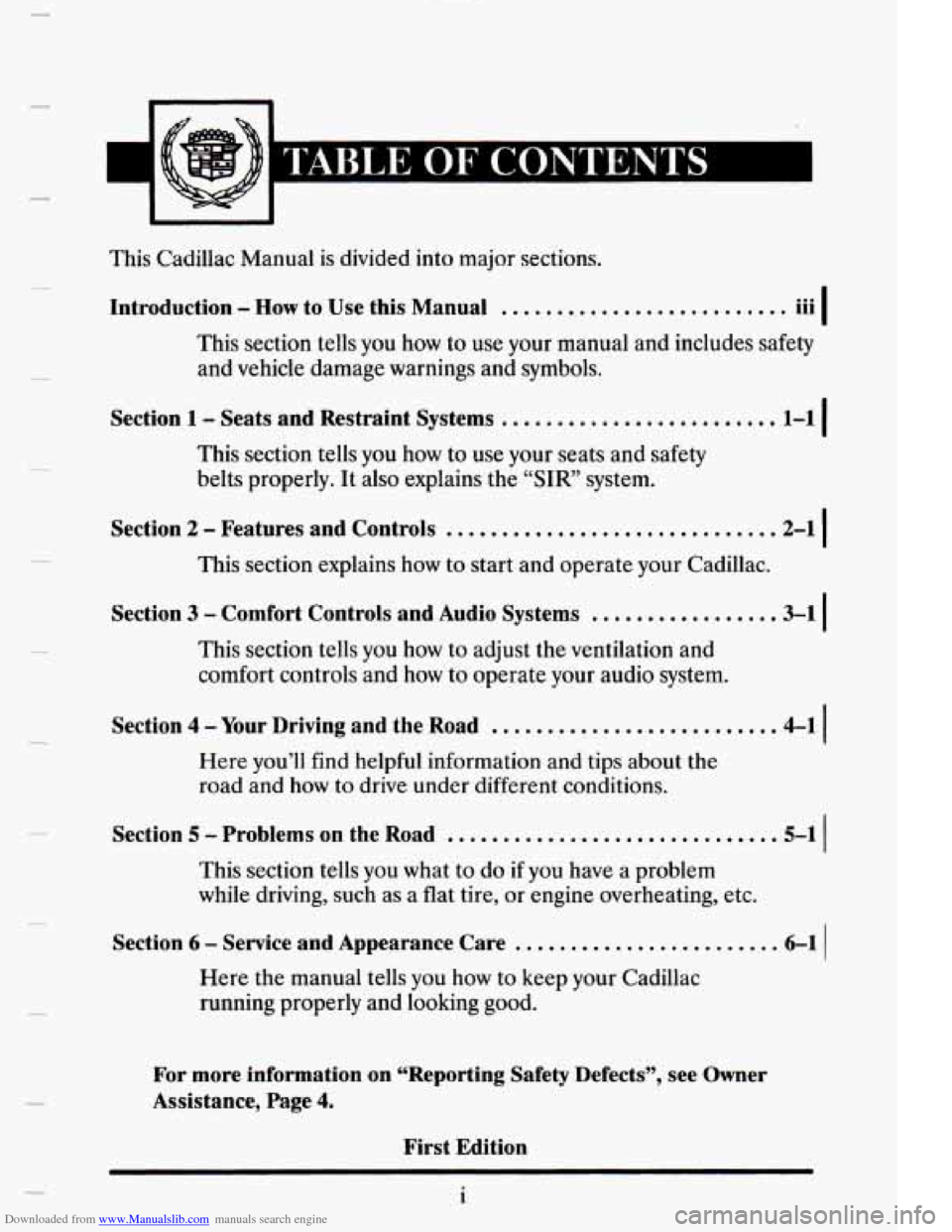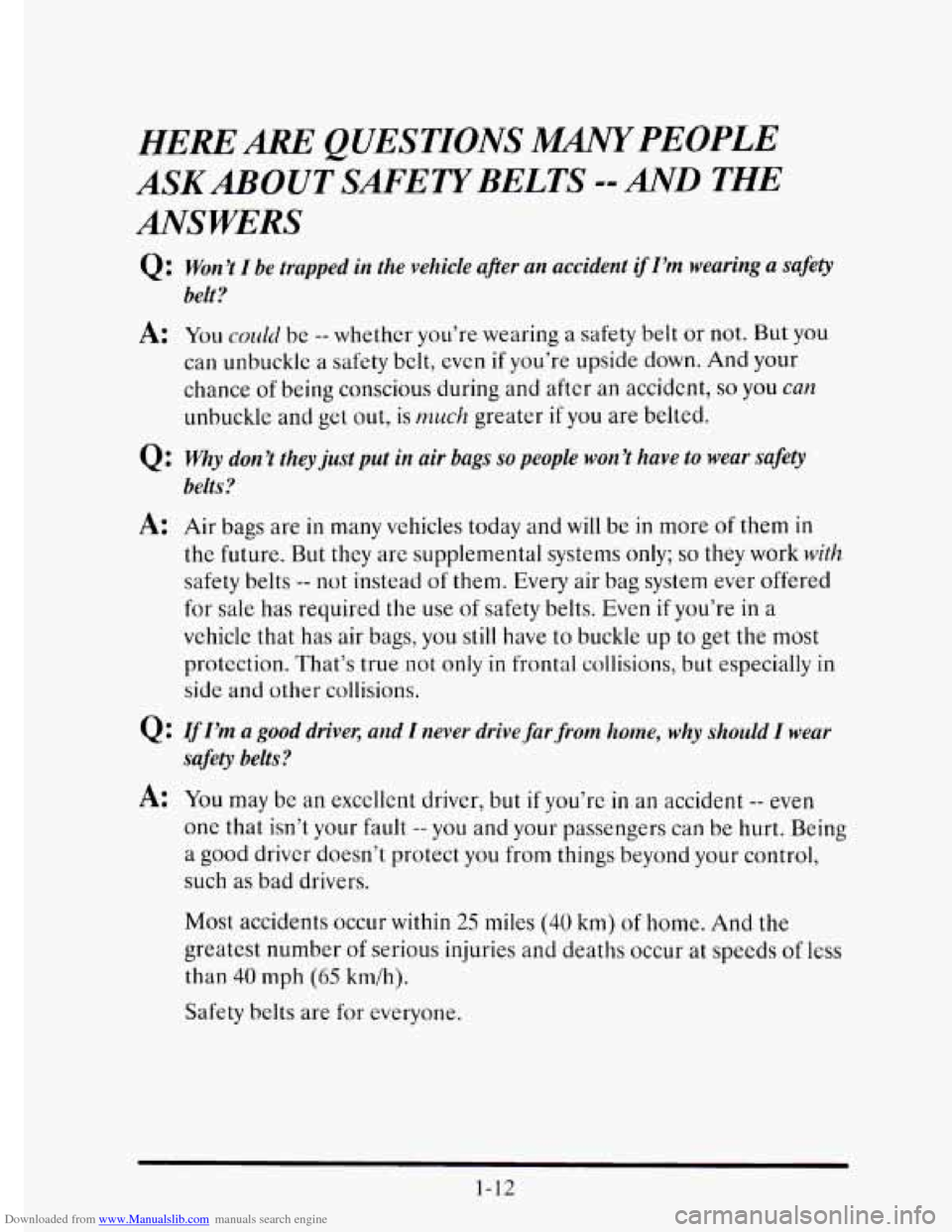Page 12 of 395

Downloaded from www.Manualslib.com manuals search engine .., ,-. I..C .,
This Cadillac Manual is divided into major sections.
Introduction - How to Use this Manual .......................... iii I
This section tells you how to use your manual and includes safety
and vehicle damage warnings and symbols.
Section 1 - Seats and Restraint Systems ......................... 1-1 I
This section tells you how to use your seats and safety
belts properly. It also explains the
“SIR’ system.
Section 2 - Features and Controls ............................. .2-1 I
This section explains how to start and operate your Cadillac.
Section 3 - Comfort Controls and Audio Systems ................. 3-1 I
This section tells you how to adjust the ventilation and
comfort controls and
how to operate your audio system.
Section 4 - Your Driving and the Road ......................... .4-1 I
Here you’ll find helpful information and tips about the
road and
how to drive under different conditions.
Section 5 - Problems on the Road ............................. .5-1 I
This section tells you what to do if you have a problem
while driving, such as a flat tire,
or engine overheating, etc.
Section 6 - Service and Appearance Care ....................... .6-1 I
Here the manual tells you how to keep your Cadillac
running properly and looking good.
For more information on “Reporting Safety Defects”, see Owner
Assistance, Page
4.
First Edition
i
Page 16 of 395
Downloaded from www.Manualslib.com manuals search engine c
Khicle Symbols
These are some of the symbols you will find on your vehicle. For example,
these symbols are used
on an original battery:
CAUTION
POSSIBLE INJURY
8
AVOID SPARKS OR FLAMES PROTECT EYES
BY SHIELDING
COULD I EXPLODE BATTERY 1
BAnERY ACID
These symbols are important for you and your passengers whenever your
vehicle is driven:
1
DOOR LOCK UNLOCK I FASTEN SEAT BELTS
a
POWER WINDOW
V
Page 26 of 395
Downloaded from www.Manualslib.com manuals search engine e
SAFETYBELTS: THEY’RE FOR EVERYONE
This part of the manual tells you how to use safety belts properly. It also
tells you some things you should not do with safety belts.
And it explains the Supplemental Inflatable Restraint, or “air bag”
system.
Your vehicle has
a light that comes on as a remindcr to buckle up. (See
“Safety Belt Reminder Light” in the Index.)
1-7
Page 27 of 395
Downloaded from www.Manualslib.com manuals search engine In many states and Canadian provinces, the law says to wear safety belts.
Here's
why: They work.
You never know if you'll be in a crash. If you do have a crash, you don't
know
if it will be a bad one.
A few crashes are mild, and some crashes can be so serious that even
buckled up
a person wouldn't survive. But most crashes are in between. In
many of them, people who buckle up can survive and sometimes walk
away. Without belts they could have been badly hurt or killed.
After more than
25 years of safety belts in vehicles, the facts are clear. In
most crashes buckling up does matter ... a lot!
/t/pty Safety Belts Work
When you ride in or on anything, you go as fast as it goes.
1-8
Page 30 of 395
Downloaded from www.Manualslib.com manuals search engine or the safety belts!
With safety belts, you
slow down as the vehicle does. You get more time to
stop. You stop over more distance, and your strongest bones take the
forces. That's why
safety belts make such good sense.
1-11
Page 31 of 395

Downloaded from www.Manualslib.com manuals search engine HERE ARE QUESTIONS lMANyPEOPLE
ANSWERS ASKABOUTSAFETYBELTS
=-AND THE
Q : Won’t I be trapped in the vehicle after an accident if I’m wearing a safety
belt?
A: You cozdcl be -- whether you’re wearing a safety belt or not. But you
can unbuckle
a safety belt, even if you’re upside down. And your
chance
of being conscious during and after an accident, so you can
unbuckle and get out, is much greater if you are belted.
Why don’t they just put in air bags so people won ’t have to wear safety
belts?
A: Air bags are in many vehicles today and will be in more of them in
the future. But they are supplemental systems only;
so they work with
safety belts -- not instead of them. Every air bag system ever offered
for sale has required
the use of safety belts. Even if you’re in a
vehicle that has air bags, you still have to buckle up to get the most
protection. That’s true not
only in frontal collisions, but especially in
side and other collisions.
Q: If I’m a good driver, and I never drive far,from home, why should I wear
safety belts?
A: You may be an excellent driver, but if you’re in an accident -- even
one that isn’t your fault -- you and your passengers can be hurt. Being
a good driver doesn’t protect you from things beyond your control,
such
as bad drivers.
Most accidents occur within
25 miles (40 km) of home. And the
greatest number
of serious injuries and deaths occur at speeds of less
than 40 mph (65 km/h).
Safety belts are
for everyone.
1-12
Page 32 of 395
Downloaded from www.Manualslib.com manuals search engine HOW TO -WEM SAFETYBELTS PROPERLY
Adults
This part is only for people of adult size.
Be aware that there are special things to know about safety belts and
children. And there are different rules for smaller children an\
d babies.
If
a child will be riding in your Cadillac, see the part of this manual called
“Children.” Follow those rules for everyone’s protection.
First, you’ll want to know which restraint systems your vehicle has.
We’ll start
with the driver position.
DRMTR POSITION
This part describes the driver’s restraint system.
Lap-Shoulder Belt
The driver has a lap-shoulder belt. Here’s how to wear it properly.
1. Close and lock the door.
2. Adjust the seat (to see how, see “Seats” in the Index) so you can sit up
straight.
1-13
Page 33 of 395
Downloaded from www.Manualslib.com manuals search engine 3. Pick up the latch
plate and pull the
belt across
you.
Don’t let it get
twisted.
4. Push the latch plate into the buckle until it clicks.
Pull up on the latch plate to make sure it is secure. If the belt isn’t long
enough, see “Safety Belt Extender” at the end of this section.
1-14
Make sure the release button on the buckle is positioned so you would
be
able to unbuckle the safety belt quickly if you ever had to.